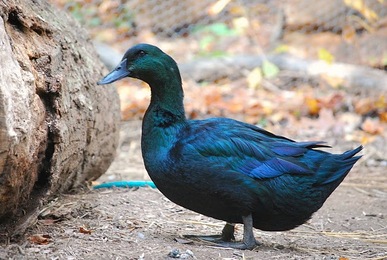Meet the Quackers

These are the laying ducks here on my farm, they are all sweet and funny characters; silly chatty gals who are a little on the clownish side. The following pictures of my ducks were taken here at Moose Manor just this winter and spring.
. . . . . . . . . . . . . . . . . . . . . . . . . . . . . . . . .
Waterfowl conservationist and author, Dave Holderread, has this to say about how duck eggs compare to chicken eggs:
"Duck eggs weigh five to eight ounces per dozen more than chicken eggs. Practical experience and tests conducted by institutions such as the University of Nebraska clearly show that duck eggs retain their freshness during storage considerably longer than those of chickens. On various occasions, we have refrigerated well-cleaned duck eggs for four months and longer with no detectable change in flavor.
"But aren't duck eggs strong-flavored?" is a common question. When duck and chicken eggs are produced with similar feeding and management, the taste of the end product is virtually indistinguishable. Over the years, we have served thousands of scrambled, fried, poached, deviled, soft boiled, souffle'd and crepe'd duck eggs to meal guests and at potlucks, picnics, wedding buffets and youth camps. In my recollection, not once has anyone suspected they weren't dining on chicken eggs until we told them otherwise. Interestingly, before being told that they were eating duck cuisine, we've had numerous people mention that the eggs were exceptionally good."
. . . . . . . . . . . . . . . . . . . . . . . . . . . . . . . . .
Waterfowl conservationist and author, Dave Holderread, has this to say about how duck eggs compare to chicken eggs:
"Duck eggs weigh five to eight ounces per dozen more than chicken eggs. Practical experience and tests conducted by institutions such as the University of Nebraska clearly show that duck eggs retain their freshness during storage considerably longer than those of chickens. On various occasions, we have refrigerated well-cleaned duck eggs for four months and longer with no detectable change in flavor.
"But aren't duck eggs strong-flavored?" is a common question. When duck and chicken eggs are produced with similar feeding and management, the taste of the end product is virtually indistinguishable. Over the years, we have served thousands of scrambled, fried, poached, deviled, soft boiled, souffle'd and crepe'd duck eggs to meal guests and at potlucks, picnics, wedding buffets and youth camps. In my recollection, not once has anyone suspected they weren't dining on chicken eggs until we told them otherwise. Interestingly, before being told that they were eating duck cuisine, we've had numerous people mention that the eggs were exceptionally good."
Welsh Harlequin (4)
'Blush' Welsh Harlequin Silver Phase Girl
A dual-purpose heritage breed, Welsh Harlequins have a wonderful temperament... they're docile, inquisitive, happy birds who are active foragers and considerably calmer than the Campbell. Harlequin are known to take to hand feeding, my girls favorite is worms and they gladly snarf them right out of my palm. These ladies have a tendency to go broody and they make excellent mothers. They don't require water for swimming to stay healthy, but they really do enjoy it. This breed was developed in 1948 when a color mutation was discovered in a flock of Khaki Campbells then selectively bred to become the do-it-all practical duck it is today. Coming from Campbell stock, they are equally as highly adaptable and outstanding layers producing 240-330 pearly white-shelled eggs yearly. These tasty eggs weigh about 2.5 ounces, which would grade them as "extra-large" and have a superb texture.
The Harlequin is listed as critical by the American Livestock Conservancy. It's in immediate need of conservation and more breeders to raise small flocks. ALBC's 2000 census of domestic waterfowl in North America found 188 breeders of Welsh Harlequins.
Read more about Welsh Harlequins here.
The Harlequin is listed as critical by the American Livestock Conservancy. It's in immediate need of conservation and more breeders to raise small flocks. ALBC's 2000 census of domestic waterfowl in North America found 188 breeders of Welsh Harlequins.
Read more about Welsh Harlequins here.
Muscovy (6)
|
I have a total of 6 Muscovy girls, all are really sweet with just the funniest little personalities! Only 2 of my hens are mature enough to lay but I expect the rest will begin this fall.
The Muscovy is not really a duck, but a large perching waterfowl native to Mexico, Central, and South America. According to some sources, the Incas of Peru domesticated Muscovy centuries ago, keeping them as pest-controlling pets and suppliers of feathers, eggs, and meat. In the wild they're a non-migratory species normally inhabitating forested swamps, lakes and streams and at night, they often roost in trees making good use of their thick, powerful legs and sharp claws. Domestic Muscovy are large, well-muscled, strong, and hardy waterfowl. They're personable and intelligent, extremely curious, and they're quiet since they don't quack: the hens have a trilling coo or soft chirp and the drakes make a huffy-puffy sound. The females love to fly around, but typically will not fly away. Muscovy are self-dependent, better foragers than other ducks, grow fast, and seldom get sick. Muscovy hens will lay 195 delicious cream-shelled eggs a year over a 40-week season. Read more about Muscovy here. |
.
Indian Runner (2)

"Sweater-duck"
An ancient breed, Indian Runners are very slender and stand upright... imagine a bowling pin with legs. This waterfowl originated in the Far East, with roots in India and Bali. Hieroglyphics depicting this upright, slender duck appear in ancient Java temple ruins indicating that Runner-type ducks have been around for over 2,000 years.
Runners are prolific layers, each hen can lay 200 or more whitish to greenish eggs per year averaging 2.8 oz., which the USDA would grade it as "Jumbo"; they have a rich flavor and texture.
I have 5 of these silly little clowns that are laying now and 4 more ducklings that hatched this summer. So my black Runner drake was busy this year :) They're such little talkers, as they trot along these girls keep up a quiet little cluck-cluck gossiping to each other all over the yard.
The Indian Runner is listed in a "watch" status by the American Livestock Breeds Conservancy. ALBC's 2000 census of domestic waterfowl in North America found 2,916 breeders of Runner ducks.
Read more about Indian Runner ducks here.
.
Dutch Hookbill (1)
|
Dutch Hookbills are an ancient and very rare breed that was nearly extinct by 1980. Thanks to the efforts of Dutch conservation breeder Hans van de Zaan and American waterfowl preservationist Dave Holderread, Europe’s oldest duck breed is gradually growing in numbers. It’s estimated that today there are 250 - 400 breeding birds left in Europe and the U.S.
Their appearance is very unique, some might describe it as peculiar. Indelibly defined by a slender head with a long downward curving bill, this gives the neck, head and bill a semi-circular appearance. Another interesting and endearing feature is that a Hookbill’s legs are not set as far forward on their bodies as other mallard-types. This gives them a distinctive non-waddle carriage and excellent land mobility; the way they move reminds me of Sandpipers. A favorite here at Moose Manor, these are really wonderful and gentle ducks! They are inquisitive, extremely quiet, very sweet, and active foragers. Hookbills are easy to handle and the males are not aggressive with the hens. The girls are very efficient seasonal layers of up to 225 large, blue colored eggs. The Hookbill is currently on the Conservation Priority List and is being studied by the American Livestock Conservancy. The limited number of active breeders has caused problems in the Netherlands resulting in large numbers of the birds killed, significantly impacting Hookbill varieties. The breed is in immediate need of more breeders to raise small flocks. |
Black Cayuga (5)

'Darkwing Duck'
I have 5 of of these low-key gals laying like gangbusters. The breed are good seasonal layers of 100-150 eggs per year with a shell color that's initially black, and as the season progresses it lightens to a very dusky grey-green color.
The plumage of the Cayuga is uniformly greenish black that's very iridescent in the sunlight but will eventually become mottled with white as they mature until it's almost all white. This changing of colors occurs much quicker in females than males. In addition, their black legs turn more orangish in color as they age.
This duck is listed as threatened by the American Livestock Conservancy. The Cayuga is in a good position to rapidly increase in number with little effort. Only a few additional breeders are needed to help further secure its future.
Read more about Black Cayuga ducks here.
The plumage of the Cayuga is uniformly greenish black that's very iridescent in the sunlight but will eventually become mottled with white as they mature until it's almost all white. This changing of colors occurs much quicker in females than males. In addition, their black legs turn more orangish in color as they age.
This duck is listed as threatened by the American Livestock Conservancy. The Cayuga is in a good position to rapidly increase in number with little effort. Only a few additional breeders are needed to help further secure its future.
Read more about Black Cayuga ducks here.
Moose Manor Farms, LLC | Moyaone Reserve, Accokeek, Maryland | (301) 678- 3533 | All Rights Reserved 2022 | NPIP 51-582 | Newsletter | Contact







